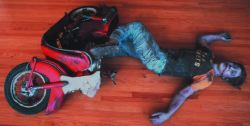Duane Hanson
Schirn Kunsthalle, Frankfurt, Germany
Schirn Kunsthalle, Frankfurt, Germany

More than Reality', a retrospective of 31 Duane Hanson 'real life' sculptures, transformed the long hall of the Schirn into a wax museum dedicated to worn-out Americans. As is usual with Hanson's work, it was easy to confuse those viewing the art with the objects on view. Most museums around the world have at least one hyperreal Hanson mannequin propped in the corner, but seeing so many examples gathered in one place gave the viewer the rare chance to contemplate the absurdity of staring at these pathetic characters, and of one man reproducing them for us to see.
The first work encountered was Housepainter (1984-8), a figure captured in the middle of painting pink the white walls of the gallery. After a double take, it became obvious that the security guard leaning against the doorway was actually the sculpture Policeman (1992-4). In this context the averted gaze of Old Couple on a Bench (1994) functioned as a gesture of etiquette: it would have been impolite of them to stare directly at the workers - the obese cleaning lady Queenie II (1988) and Delivery Man (1980) - standing in front of them.
In the main gallery the visitor was greeted by the wearisome frown of Man on a Mower (1995), Hanson's last work, completed just a year before his death at the age of 70. Other footsore sculptures from this late period leaned against the walls. Cardealer (1992) seems to be thinking about the money he might win to spend on his collection of snakeskin loafers. Cowboy (1984-95) looks as if he needs treatment for depression from the Medical Doctor (1992-4) just across from him. Perhaps his discontent stems from seeing too much of the modern man: Bodybuilder (1989-95), directly in front of him, wrestles with weights instead of cattle. Further along, the overweight Man with a Walkman (1989) has obviously never walked much further than from the parking lot to the grocery store. Flea Market Lady (1990) embodies the disillusion of this group with the ironic claim on her T-shirt: 'I am a Big Deal'. Among the other rubbish she offers for sale is a paperback copy of Joan Collins' best-selling autobiography, Past Imperfect (1978).
Other works can be seen as documenting Hanson's 'imperfect past', formative stages in his career. Until he reached 40, he was a frustrated figurative painter in an abstract-loving milieu, complaining of the 'noses and arms' that crept into his monochromes. But he only needed to go back in time to find the origins of his 'one good idea': at the age of 13 he made his first 'real life' sculpture, a wooden reproduction of Thomas Gainsborough's The Blue Boy (1770). At the end of the long hall Self Portrait with Model (1979) depicts the artist clutching an empty bottle of Coke, seated opposite an elderly lady in a house dress eating a chocolate sundae and reading the National Enquirer; a picture of Michael Jackson accompanies the magazine's headline, 'The Real Me Nobody Knows'. Nearby were examples of Hanson's more overtly political, and lesser-known, works from the 1960s: socially critical sculptures such as Abortion (1965) - the body of a woman on a stretcher covered with a white sheet - the limbless Gangland Victim (1967) and Trash (1967) - a suffocated baby lying in a rubbish bin. These works are not so much about the hyperreal depiction of real people as about expressing the mood of an angry generation.
Luckily, Hanson worked through this sensationalist phase. (He actually expressed relief that many of these early political sculptures were accidentally destroyed in a fire.) These are pulp fiction characters - tragically dramatic in comparison with the literary, tragically normal ones for which he later became known. 'Hansonesque' is a term one might imagine employed by art historians to connote a figurative sculpture of broken dreams. This retrospective made apparent not only Hanson's growth as an artist, but also the evolution of our vision of his work.





















